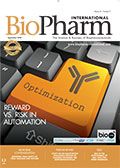Study on an Inactivation Evaluation Method of Cleaning Processes for Biopharmaceuticals
This study was successful in establishing a reliable and effective method for evaluating cleaning processes based on risk. Click here to view a PDF of this article.
science photo/Shutterstock.com

Currently, risk management based on a scientific approach is becoming required in the establishment of cleaning validation limits for pharmaceutical manufacturing equipment, as the acceptable daily exposure (ADE), which is set based on pharmacological and toxicological evaluation, is increasingly applied. At the early stage of development, ADE values may be set using the threshold of toxicological concern (TTC) approach due to lack of human data on toxicity. However, TTC values are estimates, so their application requires careful consideration. Especially in biopharmaceuticals (mainly proteins), whether or not the target product item is inactivated and degraded after cleaning is an important issue in evaluating the cleaning process. Therefore, a study was conducted by carrying out “CIP (clean in place) + SIP (steam in place)” and “CI (caustic immersion: alkaline treatment over a certain period of time)”, which are usually processes used in the cleaning of antibody drug manufacturing equipment. The inactivation and degradation of antibody drug was evaluated from the molecular structure and physiological activity point of view, using sodium dodecyl sulfate–polyacrylamide gel electrophoresis and surface plasmon resonance. This study was successful in establishing a reliable and effective method for evaluating cleaning processes based on risk.
Click
hereto view a PDF of this article.
Peer-Reviewed
Submitted: Dec. 8, 2017
Accepted: Apr. 11, 2018.
About the authors
Takashi Kaminagayoshi is director and head of manufacturing operations; Kosuke Takenaka, Tetsuya Ohta, Tomohiro Doi, and Makoto Sadamitsu are principal scientists; Shunsuke Omori is scientist; and Shinji Tsuji and Yoshiaki Miko are associate directors; all are at Biopharmaceuticals Process and Product Development, Pharmaceutical Sciences, Takeda Pharmaceutical. Osamu Shirokizawa is director and senior consultant, Life Scientia, and Andrew Walsh is president, Center for Pharmaceutical Cleaning Innovation.
Article Details
BioPharm International
Vol. 31, Number 9
September 2018
Pages: 22–28
Citation
When referring to this article, please cite as T. Kaminagayoshi et. al, “Study on an Inactivation Evaluation Method of Cleaning Processes for Biopharmaceuticals,”BioPharm International 31 (9) 2018.
